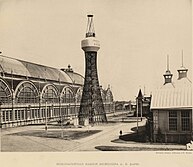 W
WHyperboloid structures are architectural structures designed using a hyperboloid in one sheet. Often these are tall structures such as towers where the hyperboloid geometry's structural strength is used to support an object high off the ground, but hyperboloid geometry is also often used for decorative effect as well as structural economy. The first hyperboloid structures were built by Russian engineer Vladimir Shukhov (1853–1939). The world's first hyperboloid tower is located in Polibino, Dankovsky District, Lipetsk Oblast, Russia.
 W
WThe Adziogol Lighthouse, also known as Stanislav–Adzhyhol Lighthouse or Stanislav Range Rear light, is one of two vertical lattice hyperboloid structures of steel bars, serving as active lighthouses in Dnieper Estuary, Ukraine. It is located about 30 km (19 mi) west of the city of Kherson. At a height of 211 feet (64 m), it is the sixteenth-tallest "traditional lighthouse" in the world as well as the tallest in Ukraine.
 W
WAspire is a work of art, constructed on the Jubilee Campus of the University of Nottingham, in Nottingham, England. It is a 60-metre (200 ft) tall, red and orange steel sculpture, and was, until overtaken by Anish Kapoor's Orbit, the tallest free standing public work of art in the United Kingdom. It is taller than B of the Bang, Nelson's Column, the Angel of the North, and the Statue of Liberty. Designed by Ken Shuttleworth and Make Architects, it consists of an 8 m (26 ft) high concrete foundation and 52 m (171 ft) high red and orange steel tower. The sculpture weighs 854 tonnes, and cost £800,000, which was donated by an anonymous benefactor. The name Aspire was chosen after a competition to name the sculpture, which was open to staff and students at the university.
 W
WAspire Tower, also known as The Torch Doha, is a 300-metre-tall (980 ft) skyscraper hotel located in the Aspire Zone complex in Doha, Qatar. Designed by architect Hadi Simaan and AREP and engineer Ove Arup and Partners, the tower served as the focal point for the 15th Asian Games hosted by Qatar in December 2006.
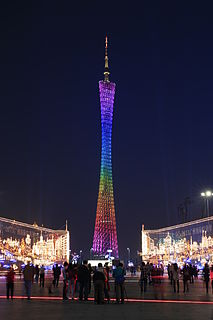 W
WThe Canton Tower, formally Guangzhou TV Astronomical and Sightseeing Tower, is a 604-meter (1,982 ft)-tall multipurpose observation tower in the Haizhu District of Guangzhou. The tower was topped out in 2009 and it became operational on 29 September 2010 for the 2010 Asian Games. The tower briefly held the title of tallest tower in the world, replacing the CN Tower, before being surpassed by the Tokyo Skytree. It was the tallest structure in China prior to the topping out of the Shanghai Tower on 3 August 2013, and is now the second tallest tower and the fourth-tallest freestanding structure in the world.
 W
WThe Capital Centre was an indoor arena in the eastern United States, located in Landover, Maryland, a suburb east of Washington, D.C.
 W
WThe Cathedral of Brasília is the Roman Catholic cathedral serving Brasília, Brazil, and serves as the seat of the Archdiocese of Brasília. It was designed by Brazilian architect Oscar Niemeyer and projected by Brazilian structural engineer Joaquim Cardozo, and was completed and dedicated on May 31, 1970. The cathedral is a hyperboloid structure constructed from 16 concrete columns, weighing 90 tons each.
 W
WThe Cockfosters Water Tower is a water tower in Cockfosters Road, north London, on the edge of Trent Park, that is known for its hyperboloid structure. It is adjacent to the Cockfosters Reservoir.
 W
WCrystal Island is a future building project in Moscow, Russia that is planned to have around 2,500,000 square meters of floor space and a height of 450 meters designed by Norman Foster. At these dimensions upon completion it would be the largest structure on earth. The architectural firm behind the design is Foster and Partners.
 W
WThe Gettysburg National Tower was a 307-foot (94 m) hyperboloid observation tower that overlooked the Gettysburg National Military Park and Gettysburg, Pennsylvania, from 1974 to 2000. The privately owned tower attracted many of the battlefield's visitors, who paid a fee to access its observation decks. Controversial even before it opened, the structure was eventually seized by eminent domain and demolished.
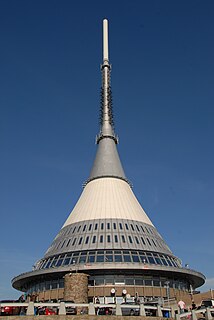 W
WJeštěd Tower is a 94-meter-tall television transmitter built on the top of Ještěd mountain near Liberec in the Czech Republic. It is made of reinforced concrete shaped in a hyperboloid form. The tower's architect is Karel Hubáček who was assisted by Zdeněk Patrman, involved in building statics, and by Otakar Binar who designed the interior furnishing. It took the team three years to finalize the structure design (1963-1966). The construction itself took seven years to finish (1966-1973).
 W
WThe Kobe Port Tower is one of the landmarks in the port city of Kobe, Japan. The sightseeing tower was completed in 1963 and paused operation from late 2009 until April 28, 2010 for renovation. It is located in the Central District, Kobe, Hyogo Prefecture, Japan.
 W
WThis page is a list of hyperboloid structures. These were first applied in architecture by Russian engineer Vladimir Shukhov (1853–1939). Shukhov built his first example as a water tower for the 1896 All-Russian Exposition. Subsequently, more have been designed by other architects, including Le Corbusier, Antoni Gaudí, Eduardo Torroja, Oscar Niemeyer and Ieoh Ming Pei.
 W
WMae West is a sculpture in Munich-Bogenhausen designed by Rita McBride. Named after the actress, the plastic artwork is a 52 meter high hyperboloid of one sheet built from carbon fiber reinforced polymer.
 W
WThe Ochsenkopf Transmitter is a 163 metres (535 ft) radio and TV tower of reinforced concrete, which was built in 1958 on the summit of the 1,024 metres (3,360 ft) Ochsenkopf mountain, the second-highest mountain in the Fichtelgebirge mountain chain in Northern Bavaria, Germany. The tower replaced a 50 metres (160 ft) guyed steel tube TV mast that collapsed in January 1958 as result of icing. The tower, which is not accessible to the public, has a hyperbolic-shaped basement with five floors for technical equipment. Above it, there are platforms for directional antennas. The antennas for FM-transmission are on the upper part of the concrete tower, those for TV transmission on a steel tube mast on the top.
 W
WThe Philips Pavilion was a World's Fair pavilion designed for Expo '58 in Brussels by the office of YAK. Commissioned by electronics manufacturer Philips, the pavilion was designed to house a multimedia spectacle that celebrated postwar technological progress. Because Corbusier was busy with the planning of Chandigarh, much of the project management was assigned to Iannis Xenakis, who was also an experimental composer and was influenced in the design by his composition Metastaseis.
 W
WThe Basílica de la Sagrada Família, also known as the Sagrada Família, is a large unfinished Roman Catholic minor basilica in the Eixample district of Barcelona, Catalonia, Spain. Designed by Spanish/Catalan architect Antoni Gaudí (1852–1926), his work on the building is part of a UNESCO World Heritage Site. On 7 November 2010, Pope Benedict XVI consecrated the church and proclaimed it a minor basilica.
 W
WThe Saint Louis Science Center, founded as a planetarium in 1963, is a collection of buildings including a science museum and planetarium in St. Louis, Missouri, on the southeastern corner of Forest Park. With over 750 exhibits in a complex of over 300,000 square feet (28,000 m2), it is among the largest of its type in the United States.
 W
WThe Shukhov Radio Tower, also known as the Shabolovka Tower, is a broadcasting tower deriving from the Russian avant-garde in Moscow designed by Vladimir Shukhov. The 160-metre-high (520 ft) free-standing steel diagrid structure was built between 1920 and 1922, during the Russian Civil War.
 W
WThe Shukhov Tower in Polibino is the world's first diagrid hyperboloid structure designed in 1896 by Russian engineer and architect Vladimir Shukhov. The tower is today located in the former estate of Yury Nechaev-Maltsov in the selo of Polibino in Lipetsk Oblast in Russia.
 W
WThe Shukhov Tower on the Oka River is the world’s only diagrid hyperboloid transmission tower. It is located in Russia, in the western suburbs of Nizhny Novgorod, on the left bank of the Oka River near Dzerzhinsk. The tower is one of several structures designed by Russian engineer and scientist Vladimir Shukhov; its power lines, however, were decommissioned in 1989.
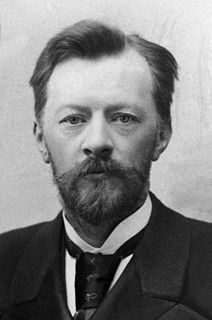 W
WVladimir Grigoryevich Shukhov was a Russian Empire and Soviet engineer-polymath, scientist and architect renowned for his pioneering works on new methods of analysis for structural engineering that led to breakthroughs in industrial design of the world's first hyperboloid structures, diagrid shell structures, tensile structures, gridshell structures, oil reservoirs, pipelines, boilers, ships and barges. He is also the inventor of the first cracking method.
 W
WStanislav Range Front Light or Small Adzhyhol Lighthouse is an active lighthouse and range light, located on a concrete pier on a tiny islet about 7 kilometres (4.3 mi) west northwest of Rybalce, about 35 kilometres (22 mi) from Kherson, Ukraine. Together with Adziogol lighthouse, located 6.49 kilometres (4.03 mi) 109° from it, it serves guiding ships entering the Dnieper River.
 W
WŚwięty Krzyż TV Tower is the tallest free-standing TV tower in Poland.. Święty Krzyż TV Tower, which was built in 1966, is a 157 metre tall concrete TV tower situated near the monastery on Łysa Góra. Święty Krzyż TV Tower is not accessible by tourists. The hyperbolic-shaped basement floors resemble those of the Ochsenkopf TV Tower in Germany.
 W
WSydney Tower is Sydney's tallest structure and the second tallest observation tower in the Southern Hemisphere. The name Sydney Tower has become common in daily usage; however, the tower has been known as the Sydney Tower Eye, AMP Tower, Flower Tower, Glower Tower, Westfield Centrepoint Tower, Big Poke, Centrepoint Tower or just Centrepoint.
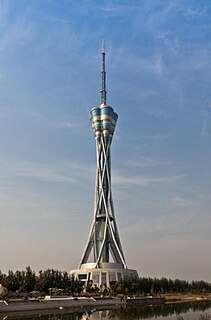 W
WZhongyuan Tower, also known as Henan Radio and Television Tower, is located in Zhengzhou, Henan province, China. It is a multi-functional commercial, artistic and cultural center integrating radio and television broadcasting, tourism, cross-border trade, cultural performance, catering and leisure.The tower is 268 meters high and the top antenna is 120 meters high, with a total height of 388 meters. It is the world's second tallest steel tower after the Tokyo Skytree.